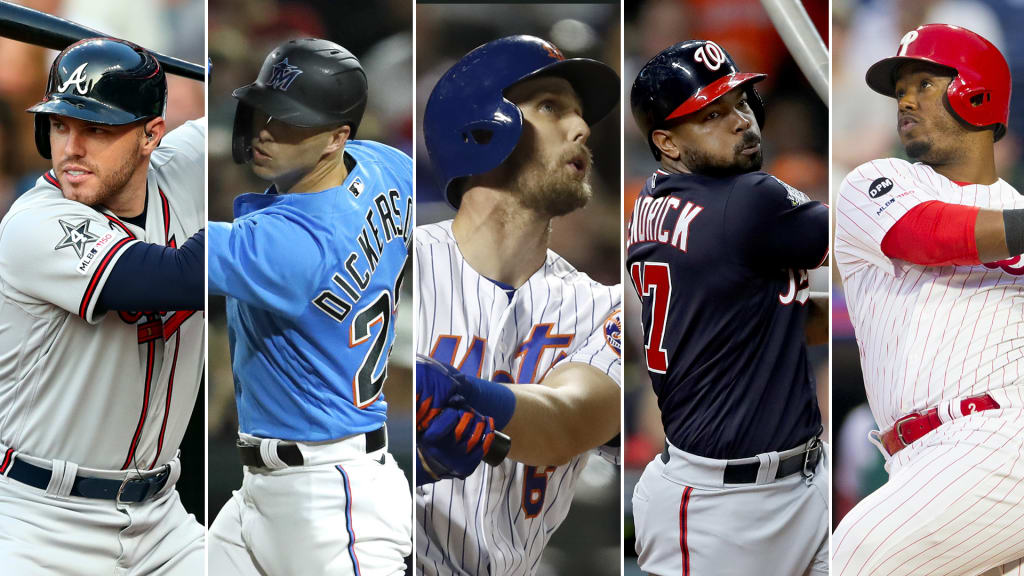
Before the best hitters in the game developed into the stars they are today, they were evaluated by scouts on a 20-80 scale based on each of five tools (hitting, power, speed, arm strength and fielding). Accounting for hand-eye coordination, swing mechanics and bat speed, the hit tool focuses on a player’s ability to hit the ball hard, make contact often, not strike out and use the whole field.
But as baseball has evolved in recent years, a larger emphasis has been placed on hitting for power rather than average. Since 2010, all but one National League batting champion compiled an average below .340, whereas in the decade prior, all but one did not cross that threshold.
Part of it can be chalked up to the rising dominance of pitchers, especially those who specialize in swing and miss. Such is the case in the NL East, where some of the best pitchers in the league reside.
But in its simplest form, baseball is still a game that depends on run production. So this week, MLB.com asked its beat reporters to choose which player on the team they cover has the best hit tool. Here are the results:
Braves: Freddie Freeman
There was some thought about going with Nick Markakis, who ranked eighth in the Majors last year with an 88.8% contact rate and fourth with a .264 batting average against pitches outside the zone. Markakis gets the bat to the ball more consistently than any other current Braves player. But the hit tool has more to do with the level of damage done against quality pitches. So we move on to either Freeman or Ronald Acuña Jr.
Acuña has the best power tool, but there’s still too much swing-and-miss in his game to say he has the best hit tool. Ozzie Albies would actually be the better candidate, and a repeat of 2019 would push him closer to that distinction. Still, there’s little reason to believe we’re going to see any sudden decline from Freeman, who has consistently hit for both power and average while standing as one of the game’s most aggressive hitters. -- Mark Bowman
Marlins: Corey Dickerson
One of the constants in manager Don Mattingly's lineup in Spring Training was batting Corey Dickerson in the No. 3 spot. That was expected to carry into the regular season, and for a good reason. Dickerson is a proven run-producer with a history of making contact. He has a career 21.3% strikeout rate, and a .331 BABIP (batting average on balls in play). Dickerson split time last season with the Pirates and Phillies, slashing .304/.341/.565 with 12 homers and 59 RBIs in 78 games. He also was worth 127 wRC+ (MLB average is 100), slightly above his career mark of 117. Dickerson also showed power with 27 homers during an All-Star season with the Rays in 2017.
“When you look at his bat-to-ball skills, and his ability to give you professional at-bats and hit in the middle of the lineup, not just for average but for power -- he made a lot of sense,” Marlins president of baseball operations Michael Hill said after signing Dickerson on Jan. 7. -- Joe Frisaro
Mets: Jeff McNeil
Despite playing in an era in which it’s harder than ever to make contact, and harder still to overcome sophisticated defensive alignments, Jeff McNeil’s .321 career batting average ranks second in Mets history among hitters with at least 800 career plate appearances. He swings at seemingly everything, leading the league last season in first-pitch hacking. It doesn’t matter. McNeil has always had a preternatural ability to put the bat on the ball, hitting .348 as a junior at Long Beach State and .311 over seven years in the Minors. It’s McNeil’s hit tool that forced the Mets to call him up to the Majors in 2018, when he batted .329 in 63 games. A year later, McNeil maintained a .318 average while increasing his home run total, from three to 23. He was one of only nine qualified National League hitters to bat above .300 last season, and one of only four to hit at least 23 homers while striking out 75 times or fewer. -- Anthony DiComo
Nationals: Howie Kendrick
Whenever Kendrick steps to the plate, the Nationals are getting a reliable at-bat. Kendrick has been a near-.300 hitter over his 14-year Major League career. Last year -- in his age-35 season -- he hit a team-best .344 over 121 games. (For context, Anthony Rendon was second with a .319 average.) Three years earlier, Kendrick batted .340 as a member of the 2017 Phillies.
When the Nats needed production during their 2019 World Series run, Kendrick came through. His 10th-inning, go-ahead grand slam in Game 5 of the National League Division Series eliminated the Dodgers. From there, he hit .333 in an NL Championship Series sweep of the Cardinals, winning the MVP Award for the series. And with one swing, Kendrick’s go-ahead home run off the right-field foul pole in Game 7 of the World Series against the Astros helped deliver the Nationals’ first title. -- Jessica Camerato
Phillies: Jean Segura
It says something about Segura’s bat-to-ball skills that he hit .280 last season and everybody considered it a down year. That is because he batted a combined .308 the previous three seasons with Arizona and Seattle. The Phillies have not had a .300 hitter since Ben Revere (.306) in 2014. Before that? Chase Utley (.332) and Aaron Rowand (.309) in 2007. Of course, folks today place more emphasis on OPS, on-base percentage and slugging percentage than batting average, but there is something to be said for somebody who can put the ball in play. Segura is one of the game’s best. His 11.8% strikeout rate last season tied for sixth-best in baseball. His 13% strikeout rate the past four seasons ranks 20th. In a swing-and-miss world, Segura’s ability to make contact makes him a valuable piece of the Phillies' lineup. -- Todd Zolecki


